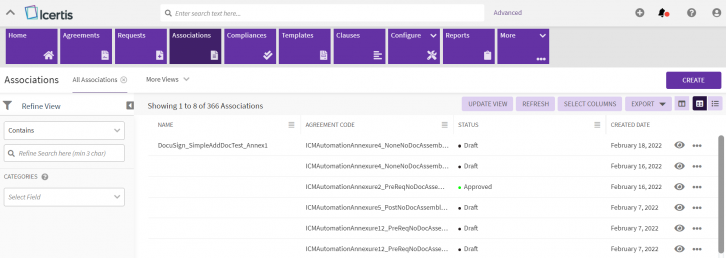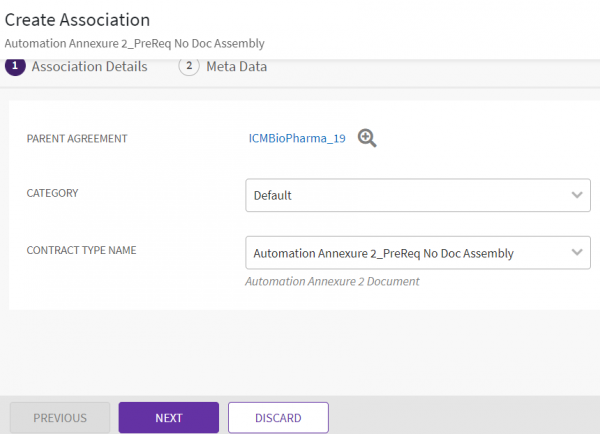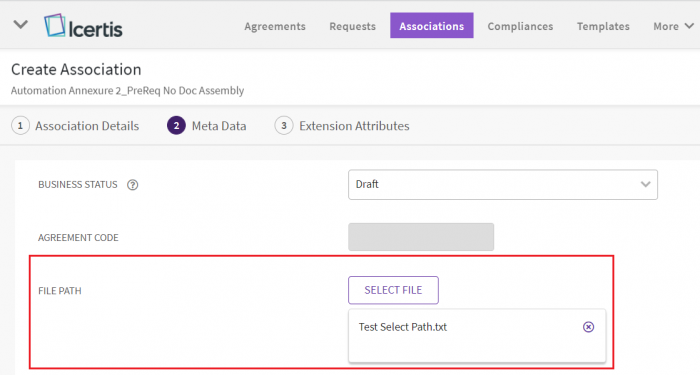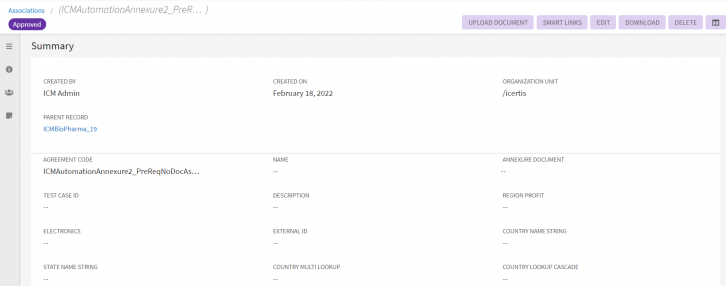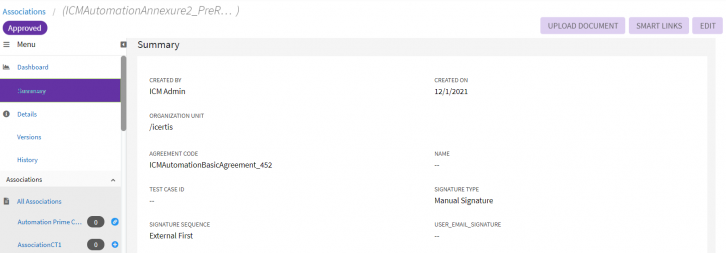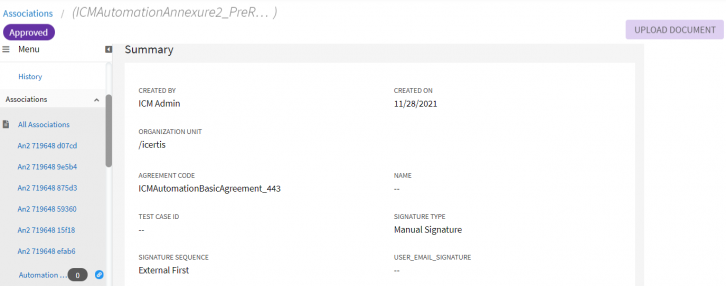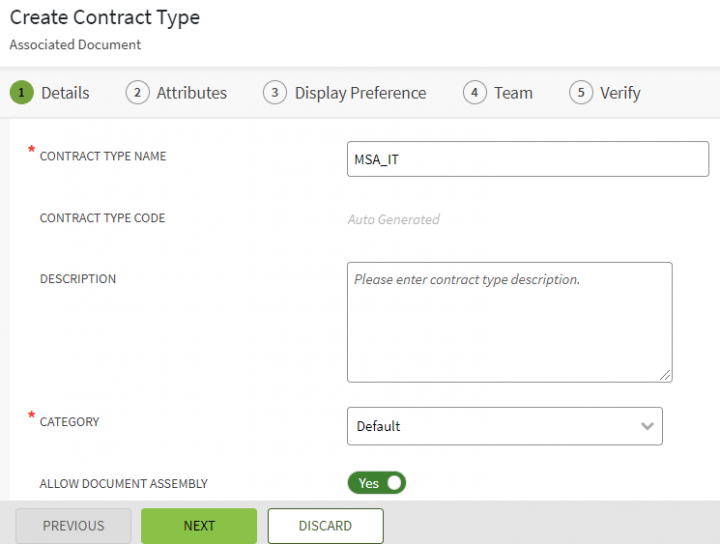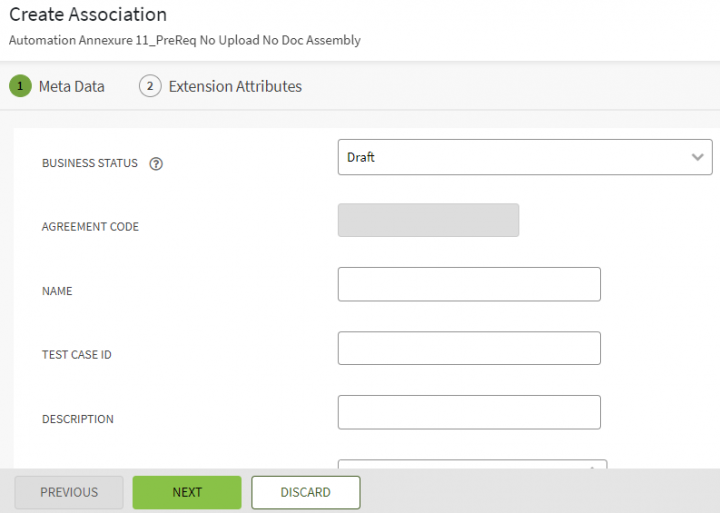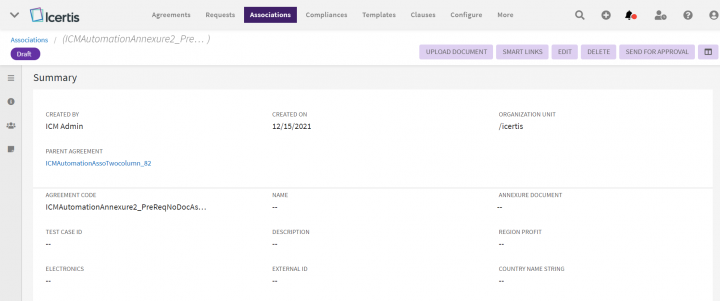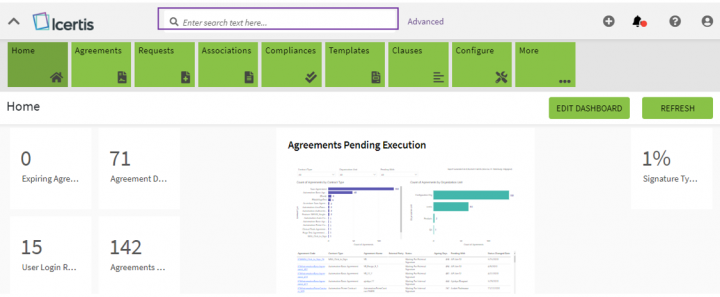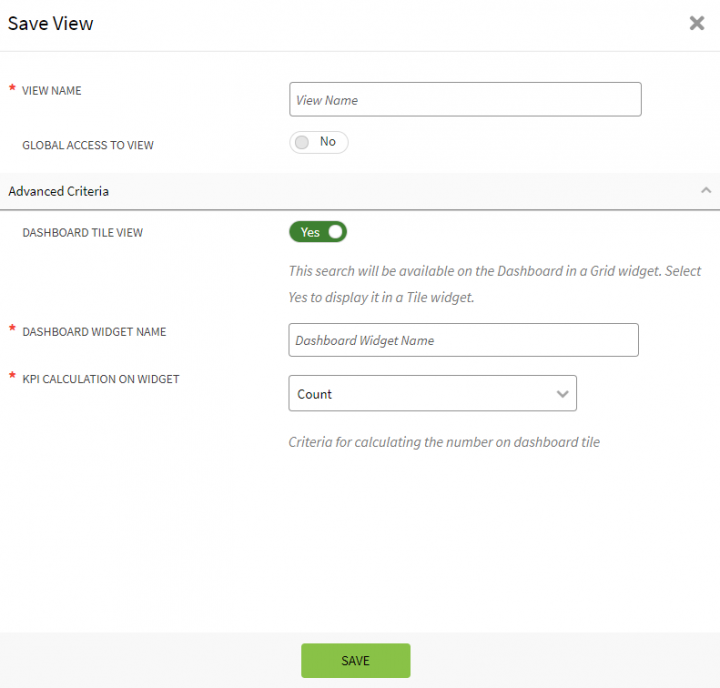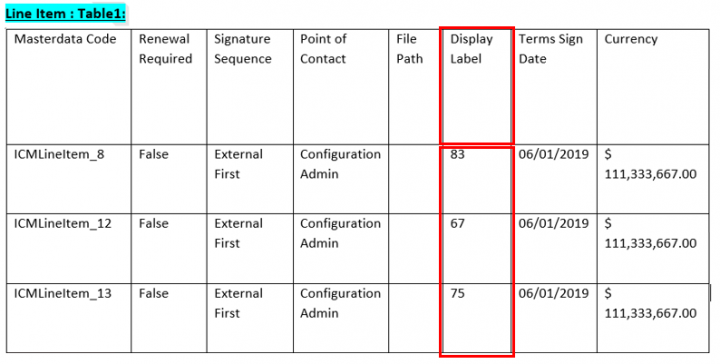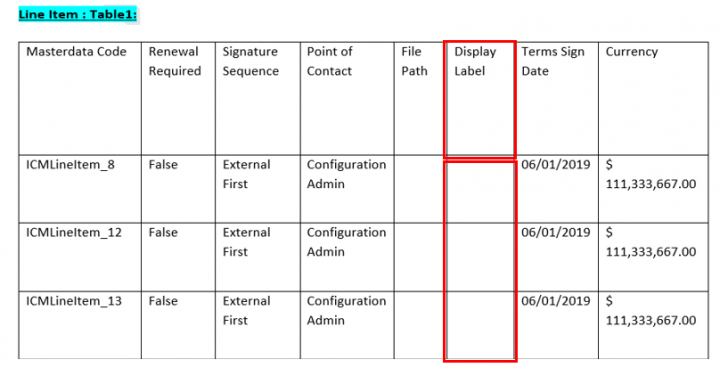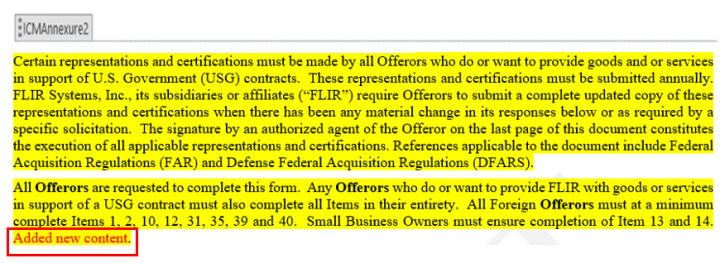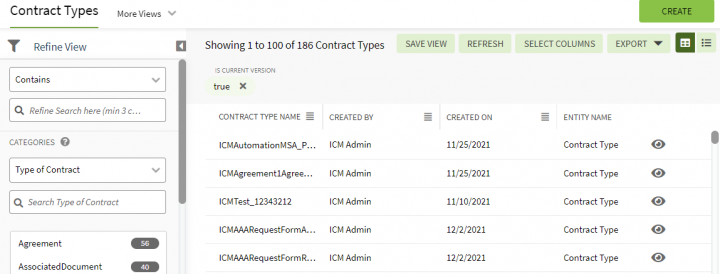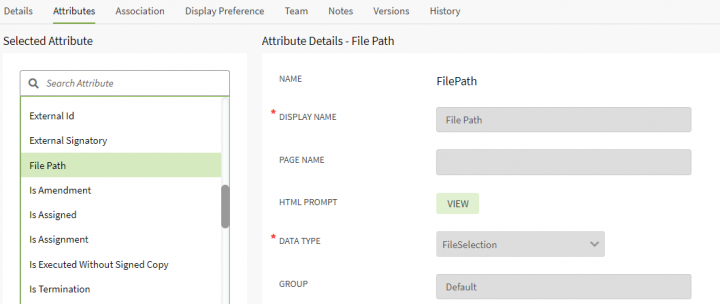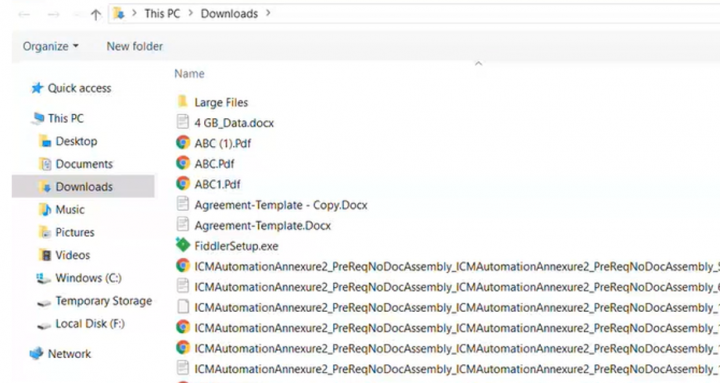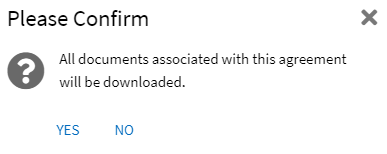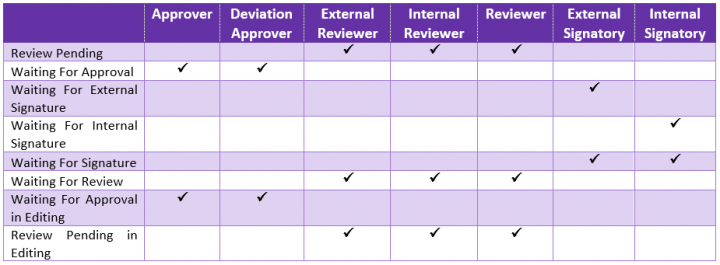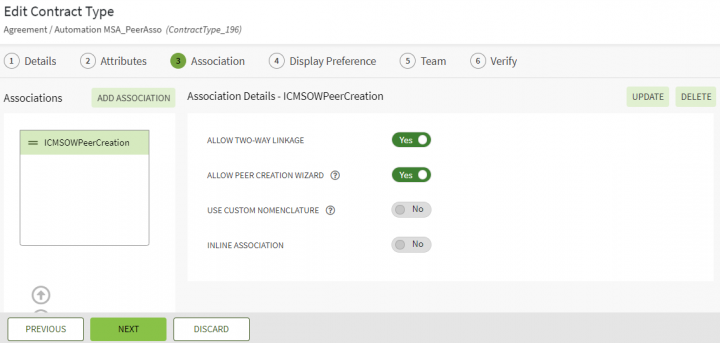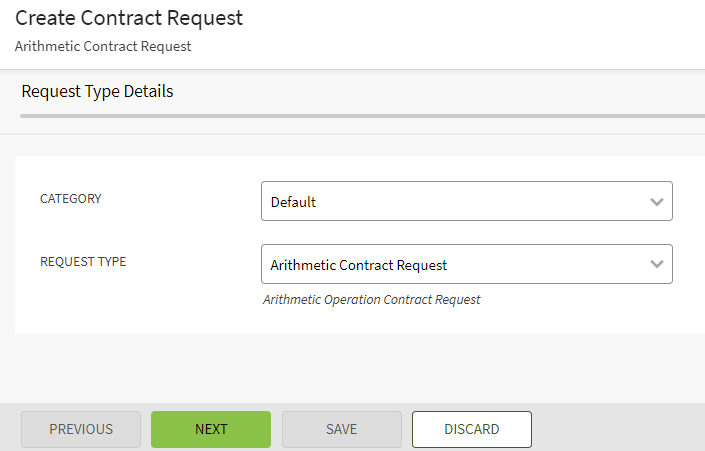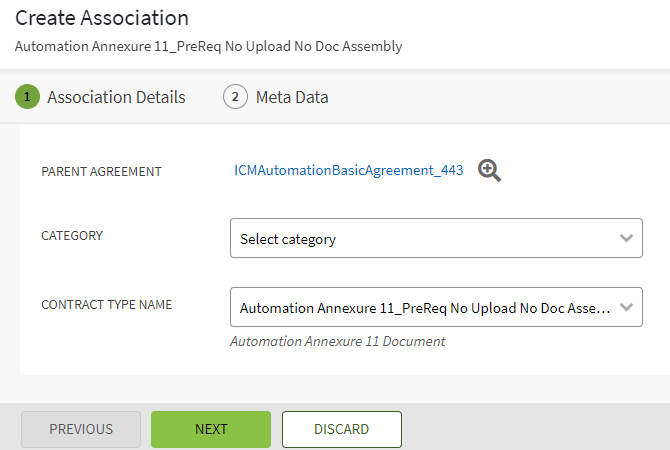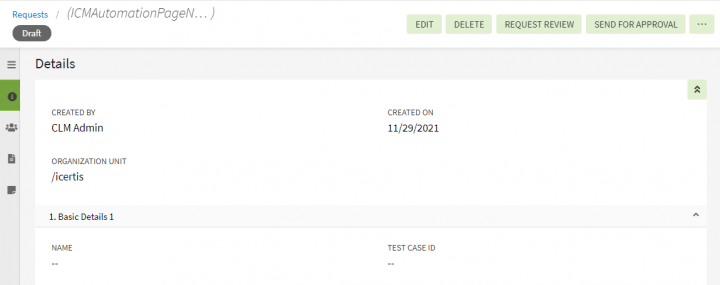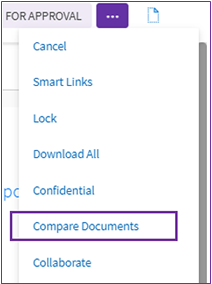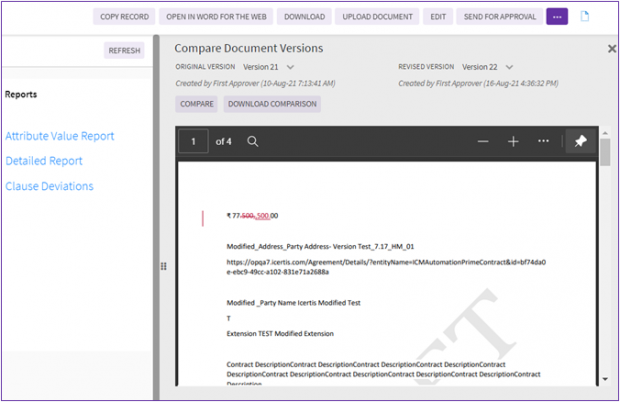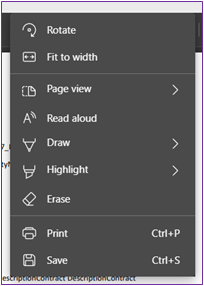Contents
- 1 Associations
- 1.1 Searching an Associated Document
- 1.2 Creating an Associated Document
- 1.3 Creating associations on create/edit wizard of agreement
- 1.4 Associations Details
- 1.5 Assembly of Associated documents based on a defined order
- 1.6 Understanding Multi-Party Agreements
- 1.7 Highlighting changes in Associations tagged as a file
- 1.8 Localization support for attribute values in tagged associations
- 1.9 Approving an Associated Document
- 1.10 Uploading and downloading large files with the File Path attribute
- 1.11 Supporting rich documents preview using MS Office for Web
- 1.12 Extending inline association support for contract request and introducing file drop functionality in inline association
- 1.13 Document Comparison
Associations
Associated documents are additional legal documents or supplementary materials added to an Agreement.
Associated documents can be:
- Created using a Template
- Uploaded into ICI
- Prepared from the Associated Document Contract Type model
From the "Associations" tile or navigation menu you can:
- Search an Associated document
- Create an Associated document
- View an Associated document
- Edit an Associated document
- Approve an Associated document
Searching an Associated Document
Use the Search feature to get relevant search results. You can use various methods to narrow down your search and locate the specific Associated Document you are looking for.
To search Associated Documents:
1. Click the "Associations" tile on the Home page.
The "Associations" page opens.
2. Search for a specific Associated Document by using any of the following options:
You can find specific associated documents you are looking for using one of these 2 methods:
- Global Search and Advance Search on the top of the page
- "Refine View" pane on the left of
- Under Search:
- Click the Select Field list, and then select the appropriate item from the list. The relevant results are populated. For example, if you select Status (to filter Associations according to the various status of associated documents), list of various states of Associated Documents is displayed. You can then select appropriate status such as Approved, draft.
- The number in the bracket denotes the number of available items which contain the search term. You can select multiple options at the same time.
- To narrow your search, type free text in the Custom Keyword box, and then click "Apply".
- Alternatively, type keywords in the "Refine Search here" box. A list of relevant Associated Documents opens.
- You can further narrow your search by using any of the following methods:
- "..." - Type the search term in double quotation marks. It shows existing Associated Documents that include the exact search term.
- ...* - Type the search term in star characters. It shows existing Associated Documents that include the exact search term.
- ... - Prefix * to the search term. It shows existing Associated Documents that end with this term.
- ...* - Suffix * to the search term. It shows existing Associated Documents that start with this term.
- "..." - Type the search term in double quotation marks. It shows existing Associated Documents that include the exact search term.
Creating an Associated Document
In ICI, you can create the Associated documents separately.
To create an Associated document:
1. Click the "Associations" tile on the "Home"page (as explained in step 1 of above section).
2. 'Click "Create" button on the "Associations' page. The "Create Association" page opens.
3. Click "Parent Agreement" icon. The Lookup Search window opens.
4. Select the parent agreement that you want the document to be associated with.
5. Click "Select". This takes you back to the Create Associated Document page with the selected document displayed in the Parent Contract field.
6. Select the Category.
7. Select the Contract Type Name.
8. Click Next. The "Metadata" tab. Click the Go to Parent Agreement link to access the relevant Parent Agreement.
9. In the Metadata tab, enter the appropriate information for the attributes.
10. Select the File Path field to upload the Associated document.
11. Click "Create". The Associated Document gets created and the Agreement Details page opens. You can see the Associations here. ICI allows you to assemble both text and images in the Association file in the main Agreement document.
Using parent’s Organization Unit path when creating associated document
During creation, the organization unit path of the parent document will be displayed by default as the org path for the associated document, thus improving the usability.
- Import of Association (Line item)
- Auto Attachment Association
- Obligation/Fulfillment (Association of Association)
Creating associations on create/edit wizard of agreement
The ability to create association instances as part of agreement creation or update wizard is being introduced in this release. A separate page is displayed, when creating or updating the agreement or amendment, for the user to create, view or delete inline associations. The user also has an option to select the columns and their order in the association grid.
Configuring Inline Associations
As a prerequisite to enable Inline Associations for an agreement, the agreement’s contract type must be configured. To configure the agreement contract type for inline associations:
1. Go to the Association tab of the agreement contract type, for example Automation Non Editable Agreement.
2. Click the plus icon next to Association. The Add Association content will be displayed.
3. Set the appropriate flags. In order to enable Inline Associations, the Inline Association flag must be set to Yes.
4. As an option you can configure a Rule on this contract type with Copy Attribute Value condition for select attributes, for example for the Contract Value.
Using Inline Associations
1. Go to "Agreements"> "Create" on the "Agreements" page. The Create Agreement page opens.

2. Select the Contract Type Name which has the Inline Associations flag enabled. For example, Automation Non Editable Agreement.
3. Click Next. The Initial Attributes page opens.
5. Click Next. The Auto-saving agreement and loading inline associations message is displayed and the page reloads displaying the Inline Association page.
7. Enter the appropriate attribute values.
8. Click "Create". The page reloads and the Association count is updated to 1. Alternatively you can click "Save And Create New" to create one association and to refresh the page for another association to be created. The “Save and Create New” action is only applicable for adding new associations and will not be available for updating or copying existing association.
- Edit: Select to open the Edit Association page in the same tab.
- View Record: Select to open the Associated Document details page in a new tab.
- Copy: Select to create a copy of the association.
- Disassociate: Select to disassociate the Association.
- View Document: Select to view an uploaded document, if any.
- View Smart Links: Select to view smart links if available.
Associations Details
The Associations can be viewed from:
- The Agreement Details page "Associations" tab.
- The "Associations" tile or menu on the navigation pane.
Refer Agreement Details page "Associations" section for the first option.
To view Association Details with the second option:
1. Click "Associations" on the main navigation menu on the top. "Associations" index page opens listing all available associations.
2. Click the eye icon in the far right on the Association you want to view. The "Associations" Details page appears.
The page has a left navigation pane, a Summary, Split View/ Preview, all relevant action buttons similar to the "Agreement Details Page".
Refer to the "Agreement Details Page" page for more details.
Assembly of Associated documents based on a defined order
ICI enables users to define the format for assembly of associations tagged as a Table or file in the main Agreement using Saved Search. This is accomplished by tagging Saved Searches of associated documents in an agreement.
Defining the order of Associated documents using Save Search
To define the order of associations using Saved Search:
1. Enter the search text in the "Enter search text here" box and then click the Search icon . The "Search" window opens.
2. Select "Obligation" from the "Please select Entitiesto Search: drop-down list.
3. Click the search icon to search all Obligation. All Obligations are displayed.
6. Enter a category or select one from the Categories drop-down. For example, "Created By".
7. Select the checkbox next to the users for which you want to view the Obligation. For example, Configuration Admin. All Agreements created by the Configuration Admin are displayed.
8. Click the Save Search icon. The Save Search window opens.
9. Enter a name in the "Save search as" field. For example, Total number of Obligations.
10. Toggle Yes for the Global Search field.
11. Toggle Yes for the Dashboard Tile field.
12. Enter a name in the Dashboard Tile Name field. For example, Total number of Obligations.
13. Click Save. The Information window opens indicating that search is saved.
Tagging of Associated Documents in the Agreement Template with Saved Search
2. Click Create to create a Template.
3. Select the contract type. For example, MSA_OM. The MSA_OM has Obligation as Associated Contract Type.
4. Enter a name for the template. For example, MSA_template.
5. Click Save. The template is saved.
6. Click the Library tab.
7. Click the Associations button.
8. Click the more actions icon. A window opens with options such as Add as file, Add as file with page break, Add as table, Add as table with page break and Add with Saved Search.
9. Click Add with Saved Search. The Select Saved Search and tag window opens.
10. Select Total number of Obligations from the drop-down list.
11. Click Add as table to add associations as a table.
12. The Obligation added to document window opens.
13. Click Save. The template is saved.
14. In the Agreement details page of ICI, let us now add some Obligations. For example, Trojan, Trojan 2 and Trojan 3.
15. Go to the Saved Searches (Total number of Obligations) and sort the Obligations of based on the descending order of End date column.
16. Click the Save Search icon to save the revised Saved Searches.
17. Click Assemble Contract on the Agreement Details page to assemble the associated document as per the revised Saved Searches.
18. Click "Preview Document" next to the agreement that you want to view.
Understanding Multi-Party Agreements
Additional platform support for Associations have been added. These enhancements support full platform functionality for Association metadata that was previously available only for Agreement metadata. The additional enhancements fall into following main areas:
- Ability to use Association Attributes in Rules
- Ability to tag Association Attributes in Agreement and Clause Templates
- Ability to use faceted search for Association Attributes from the main Search page
- Ability to compare Association tagged as a table across versions
One of the primary functional drivers for these new capabilities is to enable full functionality for Multi-party Agreements.
Making the Association type itself available while selecting Attributes
Building on the functionality around one-to-many relationships in Associations, ICI provides the ability to reference Association counts in Rule criteria. Since Rules can now be written for individual Attributes of an Association, it enables Admins to write Rules based on the count of Associations that have been added of a specific type. All attributes for Associations are available for the given Rule conditions and every Association has a specific sequence number so that the metadata of that sequence is tagged in the Template. You can search selected values of an Agreement or an Associated Document. For a multi-division Agreement, ICI supports writing Rules based on individual instances of the multi-value attributes.
When Rules are written based on the Attributes of the Association, the rules support tagging of the Metadata that belongs to the association. The associations may either be parent-child or peer. After the content control tag is entered, the value of the associated instances’ metadata is placed in the content control as shown in the example below.
Introducing a Content Control tag for Association Metadata
You can create a saved search to get the Association attribute and assemble it in the Agreement. You can sort any of the available columns. The name of the saved search is used to tag that association’s Metadata into the Template. This feature works only on Publish Agreement and Edit Agreement.
These changes to the attribute are done by editing the content control in Word manually. The example below shows the content control tag.
Note: This is not available in ICI Word Add-in.
Example:
Editing a content control tag
1.To tag the association’s metadata to the clause, edit the control tag as follows:
ICMAssociation|AssociationSavedSearchName{0}.ICMClientContactPerson
where,
- The selected Contact Person from the Contract Party association’s sequence is 1.
- The index is a zero based index. 0 means 1st instance, 1 means 2nd instance, and so on.
The sample content control will look as follows:
Click here to enter text.
Adding a content control tag
1. Check if the Developer ribbon is available in the Word menu. To enable it, go to:
File -> Options -> Customize Ribbon -> Enable Developer
2. Select Plain Text Content Control -> Properties and add the attribute’s display name in the Title.
3. Add ICMAssociation|AssociationSavedSearchName{index}.{Attribute’s Technical Name}
where,
- ICMAssociation: This is static and does not change.
- AssociationSavedSeachName: As explained above.
- Index: This is a zero based index. 0 means 1st instance, 1 means 2nd instance, and so on.
- Attribute’s Technical Name: The technical name of the attribute of Association, such as, ICMCountryName, ICMPartyName, and so on.
Comparing Association tagged as a table across Agreement versions
The functionality of alerting users on redlining of changes in Association tagged as a table is visible through the Versions tab of the Agreement document. Let’s see an example where the user edits a table tagged as Association and then uploads a revised Agreement to ICI and how ICI alerts the user regarding the changes made in the table tagged as an Association.
To edit an existing Agreement where a table is tagged as an Association:
1. Click the "Agreements" tile on the "Home" page. The "Agreements" page opens.
2. Click the View Record icon next to the Agreement in which you want to edit the Associated Document table. The Agreement Details page opens. For example, Main Sales Order 2.
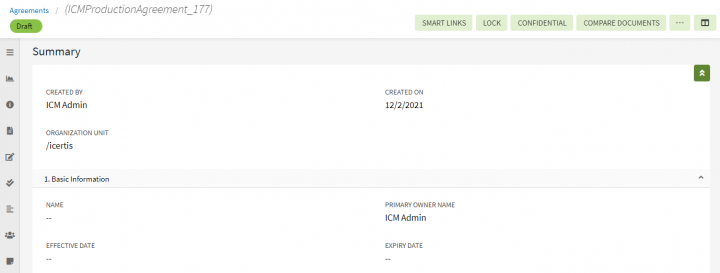
3. Click Download to download the Agreement. The Agreement gets downloaded in Microsoft Word document (.Docx) format.
4. Edit the Associated Document table. For example, let’s remove existing numbers 83, 67, and 75 from the cells of the Display Label column of Line Item: Table1.
5. Click Save.
6. Click Upload Document in ICI. The Upload Document window opens.
7. Click Select File to select the revised Template.
8. Click Upload File to upload the revised file. The "Please Confirm" window opens with a message Changes in Association Table(s).
10. Click Cancel to return to the Please Confirm window.
11. Click Yes to upload the revised Associated Document.

13. Click the Show All Details link to view the changes in the Association Table(s).
To view Associated table changes through Icertis Experience for Word
When modifications are made using the Icertis Experience for Word, a user can view the changes in the Associated table of the published Agreement.
Highlighting changes in Associations tagged as a file
ICI alerts the user and presents a summary of any text that is added or modified in association(s) tagged as file(s).
The following actions take place as soon as a new agreement version is uploaded:
- The version being uploaded is compared with the latest version available in ICI
- A window is displayed alerting the changes made in associations
Highlighting changes in Associations using Icertis Experience for Word
To view changes in Associations tagged as a file:
1. Click Download in ICI. The agreement document is downloaded.
2. Click Enable Editing to edit the agreement document.
3. Log on to Icertis Experience for Word.
4. Edit the agreement document. For example, let us edit Annexure2, which is tagged as an association as a file.
5. Click Publish. The Publish Agreement window opens.

7. Click Save. A validation message window opens indicating the warnings or errors so that you can take appropriate actions to proceed.

8. Click View all modifications. The ICI Web page opens displaying the modifications made in the association files. For example, Annexure2 association files.
9. Click Download Comparison to view the comparison between the previous agreement version and the current version. This document highlights the modifications made.
10. Go to Icertis Experience for Word.
11. Click Yes to continue uploading the document.
Highlighting changes in Associations using ICI
1. Click Download in ICI. The agreement document is downloaded.
2. Click Enable Editing to edit the agreement document.
3. Log on to Icertis Experience for Word.
4. Edit the agreement document. For example, let us edit Annexure2, which is tagged as an association as a file.

5. Save the agreement document.
6. Click Upload Document. The Upload Document window opens.
7. Click Select File. For example, ICISaasAgreement.Docx.

8. Click Upload File. The Please Confirm window opens indicating the changes in the Association File(s).
9. Click Download Comparison to view the comparison between the latest available version of the agreement and the version being uploaded. This document highlights the modifications made.
10. Click Yes to continue uploading the document.
11. Click Show All Details on the Versions tab.
Localization support for attribute values in tagged associations
The localization support has been provided for association entities assembled as a file, table or saved search in a single as well as bilingual template. The localization covers attribute data types such as string masterdata lookup, choice/multi-choice, Date and DateTime Format, Percentage, Number, Boolean and Currency format, as well as attribute groups and extension attributes on ICI UI.
This support will be available with the version upgrade without any further configuration. Here are some points to keep in mind regarding the localization for attribute values of tagged associations:
- For agreements with associations tagged as table or saved search as table, the attribute values will be displayed in local languages automatically when the document is assembled.
- For existing agreements, the attribute values will be localized when the document assembly is carried out explicitly.
- For executed or terminated agreements, the localization is not supported for attribute values of tagged associations.
When the localization is not defined, the attribute values for association entities will be displayed in a language depending on specific business criteria. To apply the localization in ICI, Administrators should maintain the translation values against respective resource keys using the Translation Editor tool. Refer to the Localization support across ICI for more details on the business scenarios.
Approving an Associated Document
When the Associated Document is created, the approval rule triggers, and the document is sent to the approvers that are set by the approver rule. If you are an approver, you can approve or reject the associated document.
To approve an Associated Document:
1. Click the Tasks tile on the Home page. The User Tasks page opens.
2. Click the Association name link that you want to approve. The Associated Document Details page opens.
3. To Approve the document, click Approve. To reject the document, click Reject. A notification is sent to the Primary and Secondary Owner of the document every time an approver approves or rejects a document.
4. If you click:
- Approve: The Add Note window opens. Type your comments and then click Add. The associated document gets approved.
- Reject: The Add Note window opens. Type your comments, select the appropriate reason code, and then click Add. The Associated Document gets rejected and goes into the Draft state.
You can enable, disable, reassign, or remove approvers using the respective buttons from the Team tab of the Association after it is created. This can be done for the Associations that are in Approved or Waiting for Approval states.
If you are an approver of the Associations for Agreements and Amendments, you can request more information for an Association that is in Waiting for Approval state using the Need More Info button. You can also remove yourself as an Approver using the Remove Mebutton for an Association that is Waiting for Approval.
Uploading and downloading large files with the File Path attribute
ICI now provides support for larger files.
Users can now:
- Large file support is added in masterdata and association only.
- Upload files up to 4GB under the file selection attribute.
- Upload files with all supported file extensions allowed in the file selection attribute.
- Download All/Download Package up to 6 GB.
- Only Azure and Windows store are supported.
ICI supports virus scanning of large files if the virus scan feature is enabled.
To upload a large file:
1. Click "Configure" > "Contract Types" > "Categories".
2. Select Type of Contract from the drop-down.
3. Select the contract type where you want to enable this functionality.
4. On the Attributes tab of the Edit Contract Type page, select any File Selection data type attribute such as File Path in the Selected Attributes column.
5. Enter a Display Name for the attribute.
6. Toggle the Enable Large File Upload to Yes. This flag provides support for large files in File Selection and File Path attributes.
Note:
- Depending on the data type, the Enable Large File Upload attribute will be enabled.
- Once this flag is enabled, it cannot be disabled.
- The attribute is always disabled for contract requests and agreements as they are not supported.
7. Click Save to save your changes and Publish.
8. Click Association Management > Create Association.
9. On the Meta Data tab, click Select File in the File Path field.
10. Select the file that you want to upload.
- If the file size does not exceed the configured limit (4GB), then the file will be uploaded and displayed on the page.
- If the file size exceeds the configured limit, a message will be displayed that the maximum allowed size had exceeded.
Note:
- For file attributes, you have to explicitly upload the file by clicking the Upload File button, unlike the file path attribute. You can also view the progress of the upload. When the file is uploaded, the progress bar turns green.
- Uploading a file may take some time depending on the network bandwidth, connection speed, file size, etc.
To download a large file:
1. When the association is created, click the Versions tab on the association Details page.
3. Click Preview if you want to preview the file. The Preview not supported for document type message will be displayed.
To download all (large) files:
1. Click the Download All button. The "Please Confirm" window opens.
2. Click "Yes".
3. On the Download window, select the files that you want to download in a zip format.
- If the file size does not exceed the configured limit (6GB), then the files will be downloaded in a zip format.
- If the file size exceeds the configured limit, a message will be displayed that the total file size exceeds the download limit.
Supporting rich documents preview using MS Office for Web
ICI is extending its rich preview experience to MS word (.doc and .docx) files which was earlier available for MS excel and PowerPoint files using Microsoft Office for Web. The rich preview is available for agreements, Amendments, Associated documents, Contract Request and Masterdata.
Using MS Office for Web viewers can preview agreements and associated documents in split view and the preview will open in drawer view for Custom file path attribute, Masterdata CT, Contract request CT, Agreements details CT and list page “Preview Document”. However, the existing supported file formats such as images and PDFs will continue to use the current technical solution to generate file previews.
Online editing of associated documents
1. In ICI Web, navigate to the agreement for which you want to edit the associated documents online.
2. In the left navigation pane, click on the Associated Documents tab. The agreement associations are displayed.
3. Click on the association you want to edit. For example, Annexure 1. The Association's Details page opens.
4. Click “Open in Office for the Web”. The page reloads and the associated document is displayed. Refer above section for more details
- The maximum file size supported is:
- DOCX: 100 MB
- XLSX: 5 MB
- PPT: 300 MB
- Check-in time supported by Microsoft:
- DOCX: 30 seconds
- PPT: 60 seconds
- XLSX: 120 seconds
Extending inline association support for contract request and introducing file drop functionality in inline association
ICI enables users to create association instances as part of agreement creation or update wizard. When creating or updating an agreement or amendment, users can create, view, or delete inline associations.
This inline associations functionality has been extended to contract request create/update wizard as well. The users can create, view or delete associations while creating or updating the contract requests.
On a separate note, a file drop zone similar to the one in agreements, has been made available on the contract request details page for the configured associated document. Support has also been added for dynamic associated document rule evaluation for partially created and saved contract requests.
This file drop functionality available on the associations grid of the agreement details page has been extended to inline associations grid in agreement as well as contract request creation wizard. The inline association functionality now supports dynamic associations for agreements, amendments and contract requests.
1. Enable the Inline Association flag while associating the association contract type with the parent contract request contract type and publish it.
2. Click “ Request” >"Create" on the "Requests" page. The Create Contract Request page opens.
3. Select the contract request contract type for which Inline Associations are configured.
4. Click Next. The Attributes page opens.
5. Update the attribute values.
6. Click Next. The contract request gets auto saved and the Inline Associations page is displayed.
Users have the option to drag-and-drop the association files into the “Drop files here…” area provided. In this case, an association gets created with the same name as the file name.
If the “Allow Multiple Association” flag is set to “No” for an association, then the file drop will be hidden and the Add button will be disabled as soon as one association gets created.
This option is available only for the Associated Documents which are created using the specific Associated Document Contract Type that has the “Show File Drop Zone” field set as Yes.
7. Click Add. The Create Association popup is displayed.
8. Enter the association details.
9. Click Create. The association gets created. Alternatively, click Save and Create New to save the association and to reset the create wizard to default values in the popup window, to create another association.
10. Click the three-dots icon in the "Actions" column to perform Edit, View Record, Disassociate, View Document and View Smart Links actions on the association.
11. Once the required associations are created, click Next to continue with the Contract Request creation wizard. The remaining workflow continues as before.
The existing ICI functionalities for associate and inherit, inheritance, auto attachment, event rule evaluation and so on will get executed at partial save (manual/auto) and create/update user actions and will continue to work with inline associations as is.
If an agreement / contract request that has not yet been saved, it will be auto saved when the user lands on the inline association page. This will enable the user to see list of evaluated associations on the inline association page.
For an agreement/contract request that has been previously saved, the user will have to explicitly update (and save) the agreement/contract request to see the new changes on the inline page.
The Dynamic Association Rule evaluation is dependent on technical configuration.
Document Comparison
The Document Comparison feature for agreements has a revamped user experience and navigation.
Here are the details of the revamped Document Comparison:
- The Document Comparison feature can be navigated from the Agreement Details page or any of the Agreement left pane tab pages, based on role-action mapping.
- To do a Document Comparison:
1. Click on the “Compare Documents” button. Alternatively, in case of page resized button availability, click on the three dots menu on the top right of the Agreement page toolbar.
2.Click “Compare Documents” from the options displayed.
- The comparison tool opens by splitting the page, with a default 60:40 ratio, with the title “Compare Document Versions”.
- 40% page-share split is the default “Compare Document Versions” part.
- The screen split margin can be dragged and adjusted as desired by the user, with the minimum mandatory limit being 30% of the page for the document comparison pane, and the maximum limit being 70%
- Within the comparison view pane, The respective version descriptions of the “Original” version and the “Revised” version are displayed on top, with the “Original” version on the left and the “Revised” version on the right.
- The compare descriptions include:
- Version number, with a dropdown arrow to choose any other version.
- The “Created by” username.
- Created date.
- Just under the descriptions, there are two buttons.
- “Compare” – Clicking this runs the version comparison.
- “Download Comparison” – Clicking this initiates the download of the comparison document.
- The document comparison preview pane is displayed below the aforementioned buttons. This is where comparative edits, omits and any changes are displayed.
- There is a header toolbar on top of the comparison preview pane.
- The header toolbar of the comparison preview pane includes, from left to right:
- Page number of total page numbers.
- Search tool displayed with a magnifying glass icon.
- Zooming out option with a “-“.
- Zooming in option with a “+”.
- Three dots menu, clicking which displays some action options.
- Pin/Unpin option.
- The comparison view can be closed by clicking the close 'X' icon, by clicking 'Compare Documents' button again, or clicking the split view button.
Related Topics: Agreement Management | Agreements | Contract Type | Saved Searches | | Adding Associations | Obligation Management

